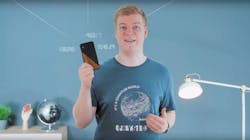The future of time determination: A video about optical clocks
July 20, 2020
3 min read
Menlo Systems (Planegg, Germany), which specializes in ultrastable lasers, frequency combs, and applications that result, has, along with YouTuber Doktor Whatson, produced a video called "Why you need an optical clock," which covers the latest technical advances that will ultimately allow frequency-comb-based optical clocks (which are already being used in labs) to augment and ultimately supplant the quartz-crystal-based microwave clocks that currently define the time standard.While the video does not not reach the level of a technical paper (thankfully, for most people), it does not shy away from technical descriptions that will help anyone with a bit of a scientific education to understand "Why you need an optical clock." Editor's note: the video is well-done, and I watched the whole thing (which I only do for a small minority of Youtube videos). Here is the video:
And here is Menlo Systems' short press release:"The typical oscillation frequency of an optical transition is about 100,000 times higher than a microwave transition. Similar to a length measurement with a fine scale rather than a coarse scale, time measurements counting those fast optical oscillations can be orders of magnitude more precise than the atomic clock technology using micro-wave transitions."Menlo Systems' complete laser system FC1500-Quantum, consisting of CW lasers referenced to an ultra-stable optical frequency comb, is a crucial element for the commercial use of the optical clock technology. The complete, rack-mounted system pro-vides the ultrastable clock laser, as well as all required CW lasers for preparing and reading out the clock transition. The optical frequency comb allows for transferring the fast optical oscillations into a measurable signal without limiting the clock precision during the readout process. With an unprecedented 10-19 frequency uncertainty throughout its entire spectral range, Menlo System's FC1500-250-ULN is the first clockwork that guarantees highest precision standards for today’s most demanding applications including optical clocks."Our new film with YouTuber Doktor Whatson describes the technology of the Physikalisch Technischen Bundesanstalt (PTB), Germany, defining our universal time, and how a redefinition of the SI second based on optical clocks will eventually influence our lives."The video is accessible through the Menlo Systems website at https://www.menlosystems.com/products/optical-frequency-combs/why-you-need-an-optical-clock/ as well as via Menlo Systems' YouTube channel at https://youtu.be/ipikcSpa4Tk.
Got optics- and photonics-related news to share with us? Contact John Wallace, Senior Editor, Laser Focus World
Get more like this delivered right to your inbox
About the Author
John Wallace
Senior Technical Editor (1998-2022)
John Wallace was with Laser Focus World for nearly 25 years, retiring in late June 2022. He obtained a bachelor's degree in mechanical engineering and physics at Rutgers University and a master's in optical engineering at the University of Rochester. Before becoming an editor, John worked as an engineer at RCA, Exxon, Eastman Kodak, and GCA Corporation.
Sign up for our eNewsletters
Get the latest news and updates

